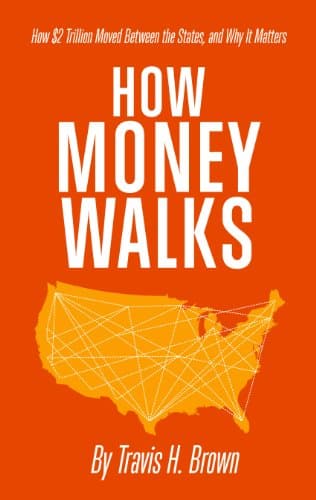Have you ever wondered how money seems to come and go? Well, let me tell you about something fascinating: how money walks. That’s right, money can actually “walk” from one place to another, impacting economies and communities along the way.
But what exactly does it mean for money to walk? Simply put, it refers to the movement of money from one geographical location to another, typically due to economic factors such as job opportunities, tax policies, or cost of living. This movement of money can have significant implications for both individuals and the places they leave behind or move to.
So, why should you care about how money walks? Understanding this concept can help you make informed choices about where to live, invest, or start a business. It can also shed light on the factors that contribute to disparity in economic growth and opportunity between different regions.
Join me as we delve into the fascinating world of how money walks, exploring the reasons behind its movement and the impact it has on our lives. Get ready for an eye-opening journey that will equip you with valuable insights into the dynamic nature of our economy. Let’s follow the path of money and discover how it can shape our financial landscapes.
Discover the Intriguing Concept of “How Money Walks?” Money has a unique way of moving around and changing communities. Explore the fascinating patterns of wealth migration and how it impacts regions across the country. Follow the money trail, uncover the reasons behind these shifts, and learn about the potential consequences for areas gaining or losing wealth. Delve into the movement of money and its profound effects on society and economic development.

How Money Walks?: Unraveling the Secrets of Wealth Migration
Welcome to a fascinating exploration of the phenomenon known as “money walks.” In this article, we will dive deep into the world of wealth migration, exploring how money moves from one place to another and the factors that drive this movement. Join us as we uncover the patterns, implications, and strategies behind the movement of money and gain insight into this intriguing economic phenomenon.
Understanding Money Migration: Why Does Money Move?
Money migration, also known as wealth migration, refers to the movement of money, assets, and individuals with high net worth from one place to another. This phenomenon is driven by various factors, including economic incentives, tax policies, lifestyle preferences, and investment opportunities.
One of the primary factors influencing money migration is taxation. Individuals and businesses may choose to relocate to areas with more favorable tax environments, such as low or no income tax states or countries with attractive tax incentives. By doing so, they can reduce their tax burdens and retain more of their wealth.
Another key driver of money migration is investment opportunities. Areas with robust economies, thriving industries, and favorable business environments tend to attract wealth and capital. Investors seek out regions with high growth potential and promising returns, resulting in the movement of money to these areas.
The Impact of Money Migration: Winners and Losers
The movement of money has significant implications for both the places people are leaving and the destinations they choose. Let’s explore the winners and losers in this dynamic process.
First, the areas people choose to leave may experience a decrease in tax revenue and economic activity. This can create challenges for governments and local businesses, requiring them to adapt and find alternative sources of revenue. Additionally, talent and expertise may be lost, impacting the workforce and overall productivity.
On the other hand, the destinations benefiting from money migration experience increased economic activity, job creation, and potential for growth. These areas attract high-net-worth individuals who bring with them investments, skills, and entrepreneurial spirit. This influx of wealth can spur innovation, infrastructure development, and improvements in the overall standard of living.
Strategies for Capitalizing on Money Migration
If you’re interested in capitalizing on money migration or navigating its effects, here are a few strategies worth considering:
- Diversify your investments: By spreading your investments across different regions and sectors, you can reduce risks associated with specific areas and potentially benefit from the economic growth of various locations.
- Stay informed about tax policies: Keeping up-to-date with tax policies and incentives in different areas can help you optimize your tax strategies and make informed decisions about where to base your wealth.
- Consider lifestyle factors: Money migration is not solely driven by financial considerations. Lifestyle preferences, cultural factors, and quality of life indicators also play a significant role. Consider how these factors align with your values and goals when making decisions about money migration.
The Future of Money Migration: Trends and Predictions
As we look ahead, several trends are shaping the future of money migration. Here are some key predictions:
1. Technology and remote work:
The rise of remote work and advancements in technology have made it easier than ever for individuals to live and work from anywhere in the world. This trend is expected to lead to increased mobility and flexibility in money migration patterns.
2. Climate change and sustainability:
Concerns over climate change and sustainability are influencing money migration decisions. Areas with environmentally-friendly policies, renewable energy initiatives, and a focus on sustainability are likely to attract wealth and investment.
3. Political and economic instability:
Political and economic instability in certain regions may lead to increased money migration. Individuals and businesses seek stability and security for their assets, driving them towards areas with more favorable conditions.
Conclusion
Money migration is an intriguing economic phenomenon that reveals the complex interplay between taxes, investments, lifestyle preferences, and economic opportunities. Understanding the drivers and implications of money migration can help individuals, businesses, and governments make informed decisions and capitalize on the opportunities it presents. Whether you’re considering relocating your wealth or simply fascinated by this aspect of the global economy, the study of money walks offers insights into the ever-evolving landscape of wealth distribution.
Key Takeaways
- The book “How Money Walks” explores how people and their wealth move between states in the United States.
- Income, taxes, and opportunities affect where people choose to live and work.
- States with lower taxes and better business climates tend to attract more money and population.
- Understanding these patterns can help policymakers and individuals make informed decisions about their finances.
- The book provides valuable insights into the relationship between money, people, and states.
Frequently Asked Questions
Welcome to our Frequently Asked Questions section on “How Money Walks.” Here, we’ll address common inquiries regarding the movement of money and its impact. Read on to gain a better understanding of this topic.
1. How does money “walk”?
Money “walking” refers to the movement of wealth from one place to another. It can happen for various reasons, such as changes in economic conditions, tax policies, or personal preferences. For example, individuals or businesses may relocate to areas with lower tax rates or better economic opportunities, resulting in the flow of money from one region to another.
Money can walk at different scales, from individuals moving assets to businesses expanding operations in new locations. Understanding the factors that cause money to walk can provide insights into economic trends and the impact of government policies on wealth distribution and economic growth.
2. What factors influence how money walks?
Multiple factors influence how money walks. Tax policies play a significant role, as regions with lower tax rates tend to attract individuals and businesses seeking to reduce their tax burden. Economic conditions, including job opportunities and cost of living, also impact money migration. Additionally, quality of life factors, such as climate, public services, and amenities, can influence the decision to relocate and the movement of money.
Furthermore, government regulations and economic incentives can shape money movement. For instance, the availability of business-friendly policies, grants, or subsidies can entice companies to invest in certain areas, contributing to the overall flow of money.
3. What are the consequences of money walking?
The consequences of money walking can be varied. On one hand, regions that attract money through favorable tax policies or economic opportunities may experience economic growth, job creation, and an increase in overall prosperity. This can lead to improved public services, infrastructure development, and a higher standard of living for residents.
On the other hand, regions that witness money outflows may face economic challenges, such as reduced tax revenue, job losses, and a decline in services. This can impact local businesses, community well-being, and overall economic stability.
4. Can money walking lead to wealth disparities?
Yes, money walking can contribute to wealth disparities between different regions. When money predominantly moves from lower-income areas to higher-income areas, it can exacerbate income inequality. This can occur if affluent individuals or businesses relocate to regions that offer more favorable economic conditions or tax advantages, leaving behind areas with fewer opportunities and resources.
Understanding the relationship between money walking and wealth disparities can shed light on economic inequality and the potential impact of policies aimed at balancing wealth distribution and promoting equal opportunity.
5. How can policymakers address the effects of money walking?
Policymakers can address the effects of money walking by implementing measures that promote economic growth and investment in all regions. This can include creating business-friendly environments, investing in infrastructure, and offering incentives to retain or attract wealthy individuals and businesses.
Furthermore, addressing income inequality through equitable tax policies, social programs, and targeted investments in education and job training can help mitigate the negative consequences of money walking and create opportunities for all communities to thrive.
NTU Interview with “How Money Walks” Author Travis Brown
Summary
So, what did we learn? Well, “How Money Walks” shows us that people move where opportunity is. They go to states with low taxes and good job prospects, and they leave states that don’t offer those things. This movement of people has a big impact on which states thrive and which ones struggle. By understanding this movement, we can see how important it is for states to create an environment that attracts people and allows them to thrive economically.
